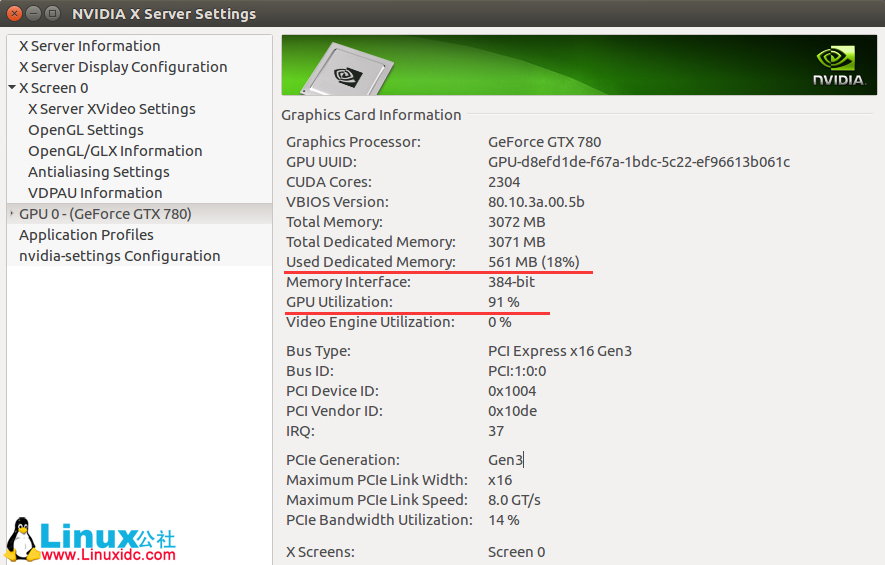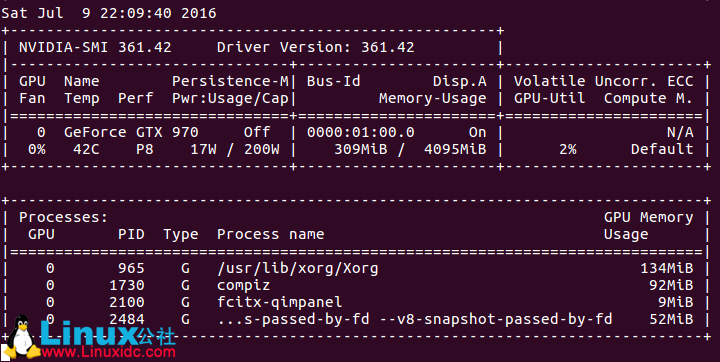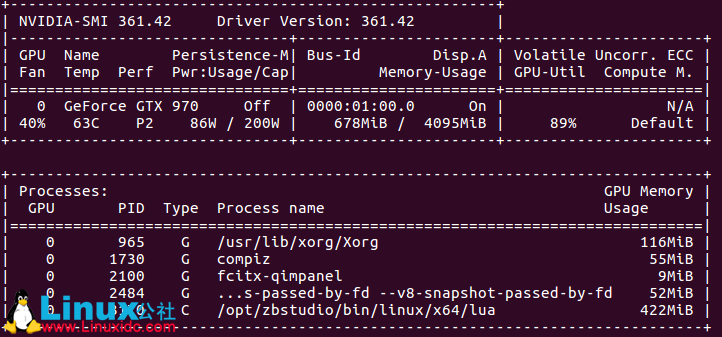共计 8603 个字符,预计需要花费 22 分钟才能阅读完成。
对于使用 C 语言和 C++ 来开发 GPU 加速应用程序的开发者来说,NVIDIA CUDA Toolkit 可提供一个综合的开发环境。CUDA Toolkit 包含一个针对英伟达 GPU 的编译程序、诸多数学库以及可用于调试和优化应用程序性能的各种工具。你还将找到编程指南、用户手册、API 参考、以及能够帮助你快速着手开发 GPU 加速应用程序的其它文档。
说明:由于 Nvidia 并未给出 Ubuntu 16.04 上面的 CUDA Toolkit,本文方法不一定可行,我这边安装成功,感觉完全是瞎猫碰死耗子了。不过没有安装 sample,只是其他程序可以使用显卡了。
1. 第一个网址,使用
sudo apt-get install nvidia-cuda-toolkit安装 cuda toolkit,要看网速,下载很慢。还有,网址中说重启 ubuntu 有问题(I can’t log in to my computer and end up in infinite login screen)。我这边安装了之后,正常登陆了,没有出现问题。
2. 安装完之后的信息:
装的是 7.5.17,不是最新的 7.5.18,但是能用就行。

3. 第二个网址中 qed 给出了在终端中持续显示 GPU 当前的使用率(仅限 nvidia 的显卡):
nvidia-smi -l 1
结果:

说明:上面的命令貌似要显卡支持才行。也可以使用 Jonathan 提供的命令(目前没测试):
watch -n0.1 "nvidia-settings -q GPUUtilization -q useddedicatedgpumemory"160713 说明 :a. 这条命令显示信息如下:

b. 其实这条命令就是在终端中显示‘NVIDIA X serve settings’中的一些信息,如下(NVIDIA X serve settings 位置为 /usr/share/applications,也可以直接打开该软件查看):

c. 由于这张图使用的 GPU 和之前使用的 GPU 不一样,因而参数不一致(比如显存)。
4. 安装完 cuda 之后,安装 cutorch,之后安装 cunn,都安装成功。使用 GPU 的程序也能正常运行。
5. 第三个参考网址中给出了测试程序,本处稍微进行了修改,打印出来每次循环执行的时间(CPU 版本和 GPU 版本代码实际上差不多):
① CPU 版本:
require 'torch'
require 'nn'
require 'optim'
--require 'cunn'
--require 'cutorch'
mnist = require 'mnist'
fullset = mnist.traindataset()
testset = mnist.testdataset()
trainset = {size = 50000,
data = fullset.data[{{1,50000}}]:double(),
label = fullset.label[{{1,50000}}]
}
validationset = {size = 10000,
data = fullset.data[{{50001,60000}}]:double(),
label = fullset.label[{{50001,60000}}]
}
trainset.data = trainset.data - trainset.data:mean()
validationset.data = validationset.data - validationset.data:mean()
model = nn.Sequential()
model:add(nn.Reshape(1, 28, 28))
model:add(nn.MulConstant(1/256.0*3.2))
model:add(nn.SpatialConvolutionMM(1, 20, 5, 5, 1, 1, 0, 0))
model:add(nn.SpatialMaxPooling(2, 2 , 2, 2, 0, 0))
model:add(nn.SpatialConvolutionMM(20, 50, 5, 5, 1, 1, 0, 0))
model:add(nn.SpatialMaxPooling(2, 2 , 2, 2, 0, 0))
model:add(nn.Reshape(4*4*50))
model:add(nn.Linear(4*4*50, 500))
model:add(nn.ReLU())
model:add(nn.Linear(500, 10))
model:add(nn.LogSoftMax())
model = require('weight-init')(model, 'xavier')
criterion = nn.ClassNLLCriterion()
--model = model:cuda()
--criterion = criterion:cuda()
--trainset.data = trainset.data:cuda()
--trainset.label = trainset.label:cuda()
--validationset.data = validationset.data:cuda()
--validationset.label = validationset.label:cuda()--[[]]
sgd_params = {learningRate = 1e-2,
learningRateDecay = 1e-4,
weightDecay = 1e-3,
momentum = 1e-4
}
x, dl_dx = model:getParameters()
step = function(batch_size)
local current_loss = 0
local count = 0
local shuffle = torch.randperm(trainset.size)
batch_size = batch_size or 200
for t = 1,trainset.size,batch_size do
-- setup inputs and targets for this mini-batch
local size = math.min(t + batch_size - 1, trainset.size) - t
local inputs = torch.Tensor(size, 28, 28)--:cuda()
local targets = torch.Tensor(size)--:cuda()
for i = 1,size do
local input = trainset.data[shuffle[i+t]]
local target = trainset.label[shuffle[i+t]]
-- if target == 0 then target = 10 end
inputs[i] = input
targets[i] = target
end
targets:add(1)
local feval = function(x_new)
-- reset data
if x ~= x_new then x:copy(x_new) end
dl_dx:zero()
-- perform mini-batch gradient descent
local loss = criterion:forward(model:forward(inputs), targets)
model:backward(inputs, criterion:backward(model.output, targets))
return loss, dl_dx
end
_, fs = optim.sgd(feval, x, sgd_params)
-- fs is a table containing value of the loss function
-- (just 1 value for the SGD optimization)
count = count + 1
current_loss = current_loss + fs[1]
end
-- normalize loss
return current_loss / count
end
eval = function(dataset, batch_size)
local count = 0
batch_size = batch_size or 200
for i = 1,dataset.size,batch_size do
local size = math.min(i + batch_size - 1, dataset.size) - i
local inputs = dataset.data[{{i,i+size-1}}]--:cuda()
local targets = dataset.label[{{i,i+size-1}}]:long()--:cuda()
local outputs = model:forward(inputs)
local _, indices = torch.max(outputs, 2)
indices:add(-1)
local guessed_right = indices:eq(targets):sum()
count = count + guessed_right
end
return count / dataset.size
end
max_iters = 5
do
local last_accuracy = 0
local decreasing = 0
local threshold = 1 -- how many deacreasing epochs we allow
for i = 1,max_iters do
timer = torch.Timer()
local loss = step()
print(string.format('Epoch: %d Current loss: %4f', i, loss))
local accuracy = eval(validationset)
print(string.format('Accuracy on the validation set: %4f', accuracy))
if accuracy < last_accuracy then
if decreasing > threshold then break end
decreasing = decreasing + 1
else
decreasing = 0
end
last_accuracy = accuracy
print('Time elapsed: ' .. i .. 'iter: ' .. timer:time().real .. ' seconds')
end
end
testset.data = testset.data:double()
eval(testset)② GPU 版本:
require 'torch'
require 'nn'
require 'optim'
require 'cunn'
require 'cutorch'
mnist = require 'mnist'
fullset = mnist.traindataset()
testset = mnist.testdataset()
trainset = {size = 50000,
data = fullset.data[{{1,50000}}]:double(),
label = fullset.label[{{1,50000}}]
}
validationset = {size = 10000,
data = fullset.data[{{50001,60000}}]:double(),
label = fullset.label[{{50001,60000}}]
}
trainset.data = trainset.data - trainset.data:mean()
validationset.data = validationset.data - validationset.data:mean()
model = nn.Sequential()
model:add(nn.Reshape(1, 28, 28))
model:add(nn.MulConstant(1/256.0*3.2))
model:add(nn.SpatialConvolutionMM(1, 20, 5, 5, 1, 1, 0, 0))
model:add(nn.SpatialMaxPooling(2, 2 , 2, 2, 0, 0))
model:add(nn.SpatialConvolutionMM(20, 50, 5, 5, 1, 1, 0, 0))
model:add(nn.SpatialMaxPooling(2, 2 , 2, 2, 0, 0))
model:add(nn.Reshape(4*4*50))
model:add(nn.Linear(4*4*50, 500))
model:add(nn.ReLU())
model:add(nn.Linear(500, 10))
model:add(nn.LogSoftMax())
model = require('weight-init')(model, 'xavier')
criterion = nn.ClassNLLCriterion()
model = model:cuda()
criterion = criterion:cuda()
trainset.data = trainset.data:cuda()
trainset.label = trainset.label:cuda()
validationset.data = validationset.data:cuda()
validationset.label = validationset.label:cuda()--[[]]
sgd_params = {learningRate = 1e-2,
learningRateDecay = 1e-4,
weightDecay = 1e-3,
momentum = 1e-4
}
x, dl_dx = model:getParameters()
step = function(batch_size)
local current_loss = 0
local count = 0
local shuffle = torch.randperm(trainset.size)
batch_size = batch_size or 200
for t = 1,trainset.size,batch_size do
-- setup inputs and targets for this mini-batch
local size = math.min(t + batch_size - 1, trainset.size) - t
local inputs = torch.Tensor(size, 28, 28):cuda()
local targets = torch.Tensor(size):cuda()
for i = 1,size do
local input = trainset.data[shuffle[i+t]]
local target = trainset.label[shuffle[i+t]]
-- if target == 0 then target = 10 end
inputs[i] = input
targets[i] = target
end
targets:add(1)
local feval = function(x_new)
-- reset data
if x ~= x_new then x:copy(x_new) end
dl_dx:zero()
-- perform mini-batch gradient descent
local loss = criterion:forward(model:forward(inputs), targets)
model:backward(inputs, criterion:backward(model.output, targets))
return loss, dl_dx
end
_, fs = optim.sgd(feval, x, sgd_params)
-- fs is a table containing value of the loss function
-- (just 1 value for the SGD optimization)
count = count + 1
current_loss = current_loss + fs[1]
end
-- normalize loss
return current_loss / count
end
eval = function(dataset, batch_size)
local count = 0
batch_size = batch_size or 200
for i = 1,dataset.size,batch_size do
local size = math.min(i + batch_size - 1, dataset.size) - i
local inputs = dataset.data[{{i,i+size-1}}]:cuda()
local targets = dataset.label[{{i,i+size-1}}]:long():cuda()
local outputs = model:forward(inputs)
local _, indices = torch.max(outputs, 2)
indices:add(-1)
local guessed_right = indices:eq(targets):sum()
count = count + guessed_right
end
return count / dataset.size
end
max_iters = 5
do
local last_accuracy = 0
local decreasing = 0
local threshold = 1 -- how many deacreasing epochs we allow
for i = 1,max_iters do
timer = torch.Timer()
local loss = step()
print(string.format('Epoch: %d Current loss: %4f', i, loss))
local accuracy = eval(validationset)
print(string.format('Accuracy on the validation set: %4f', accuracy))
if accuracy < last_accuracy then
if decreasing > threshold then break end
decreasing = decreasing + 1
else
decreasing = 0
end
last_accuracy = accuracy
print('Time elapsed: ' .. i .. 'iter: ' .. timer:time().real .. ' seconds')
end
end
testset.data = testset.data:double()
eval(testset)6. CPU 和 GPU 使用率
① CPU 版本
CPU 情况:

GPU 情况:

② GPU 版本
CPU 情况:

GPU 情况:

7. 可以看出,CPU 版本的程序,CPU 全部使用上了,GPU 则基本没用。GPU 版本,只有一个核心(线程)的 CPU 完全是用上了,其他的则在围观。。。而 GPU 使用率已经很高了。
8. 时间比较
CPU 版本:
Epoch: 1 Current loss: 0.619644
Accuracy on the validation set: 0.924800
Time elapsed: 1iter: 895.69850516319 seconds
Epoch: 2 Current loss: 0.225129
Accuracy on the validation set: 0.949000
Time elapsed: 2iter: 914.15352702141 secondsGPU 版本:
Epoch: 1 Current loss: 0.687380
Accuracy on the validation set: 0.925300
Time elapsed: 1iter: 14.031280994415 seconds
Epoch: 2 Current loss: 0.231011
Accuracy on the validation set: 0.944000
Time elapsed: 2iter: 13.848378896713 seconds
Epoch: 3 Current loss: 0.167991
Accuracy on the validation set: 0.959800
Time elapsed: 3iter: 14.071791887283 seconds
Epoch: 4 Current loss: 0.135209
Accuracy on the validation set: 0.963700
Time elapsed: 4iter: 14.238609790802 seconds
Epoch: 5 Current loss: 0.113471
Accuracy on the validation set: 0.966800
Time elapsed: 5iter: 14.328102111816 seconds说明:① CPU 为 4790K@4.4GHZ(8 线程全开时,应该没有这么高的主频,具体多少没注意);GPU 为 nvidia GTX 970。
② 由于 CPU 版本的执行时间实在太长,我都怀疑程序是否有问题了。。。但是看着 CPU 一直 100% 的全力工作,又不忍心暂停。直到第一次循环结束,用了将近 900s,才意识到,原来程序应该木有错误。。。等第二次循环结束,就直接停止测试了。。。GPU 版本的程序,每次循环则只用 14s,时间上差距。。。额,使用 CPU 执行时间是 GPU 执行时间的 64 倍。。。
更多 Ubuntu 相关信息见 Ubuntu 专题页面 http://www.linuxidc.com/topicnews.aspx?tid=2
本文永久更新链接地址 :http://www.linuxidc.com/Linux/2016-07/133200.htm





















